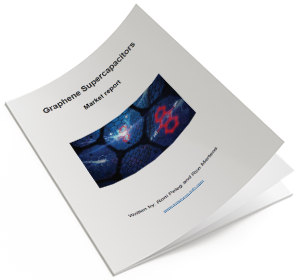The Graphene-Info newsletter, September 2016
Published: Tue, 10/04/16
Lomiko to present graphene supercapacitor prototype at Battery Materials Conference in Toronto
Lomiko Metals has announced that it will be presenting a summary of the Graphene Energy Storage Devices Corp. (GESD) Graphene Supercapacitor Project at the Battery Material Conference in Toronto September 2016. This development may enable new compact energy storage solutions for grid and vehicular applications.
GESD is currently working on scale-up of the technology and an in-field evaluation of the energy storage unit with Stony Brook University. The GESD-SBU team demonstrated design and implementation of a sealed high-voltage EDLCs energy storage unit. The unit is internally balanced, there is no need for an external circuit. The electrode is very cost-effective nano-carbon composite either of a commercial carbon or of graphene platelets with carbon nanotubes.
The nano-carbon electrode materials were used for deposition and assembly of a working prototype of an internally balanced high-voltage energy storage unit. The bench-top prototype unit, tested up to 10 V, exhibited good discharge characteristics and charge retention.
Directa Plus launches graphene-based 3D printing material
Italy-based Directa Plus announced the launch of GRAFYLON 3D, a graphene-enhanced filament for 3D printing. The new product has been developed in collaboration with FILOALFA, a division of Ciceri de Mondel that specializes in producing filaments used in 3D printing, and is now commercially available. RAFYLON® 3D is available starting today for purchase directly from the FILOALFA website and from FILOALFA’s dealers.
GRAFYLON 3D is a new generation of polylactic acid-based (PLA) filament containing Directa’s graphene-based product. In 3D printing, hundreds or thousands of layers of material are “printed” layer upon layer using various materials, most commonly plastic polymers such as PLA filaments. The inclusion of the company's Graphene Plus enhances the filament’s properties, while reportedly maintaining a competitive price. During testing, the following improvements in performance compared with non-graphene-based 3D filaments were observed:
- Improvement in surface finish, with a unique aesthetic effect
- Thermal conduction properties
- Elastic modulus improvement by 34%
- Tensile strength higher by 23%
- Elongation higher by 28%
Talga Resources to collaborate with German JennaBatteries on graphene-enhanced flow batteries
Talga Resources recently signed a collaboration agreement with JenaBatteries to jointly explore the use of Talga’s graphene products in flow batteries. Under the Agreement, Talga will formulate and supply graphene for testing in components producing JenaBatteries’ patented polymer flow battery, a type of redox flow battery suitable for commercial scale and grid applications.
Talga’s graphene will aim to reduce manufacturing costs and increase the performance and longevity of the flow battery components by utilizing graphene’s properties of conductivity, chemical inertness and impermeability. The collaboration provides a platform for Talga’s graphene to be introduced to the large stationary energy storage sector, using variants of its graphene already developed for mobile energy applications.NanoXplore to partner with SDTC on graphene-enhanced components for electric motor systems
Group NanoXplore, a Canadian company specializing in the production and application of graphene and its derivative materials, has announced that Sustainable Development Technology Canada (SDTC) will partner with the company to support the commercialization of lighter, more reliable and higher-efficiency components for electric motor systems using graphene-enhanced engineering plastics in place of metals. The total value of the project is $10.4 million.
Replacing metals with plastics will require innovative polymers with unique thermal, electrical, and strength characteristics. NanoXplore has developed and is providing customers with graphene-enhanced polymers with enhanced electrical, thermal and mechanical properties. By adding trace amounts of graphene to carefully-selected polymers, engineering plastics can be tailored to improve electric motors and the systems they are used in.
Meet the Graphene-Info team at Printed & Flexible Electronics China 2017
On January 11-13 2017 Shanghai will be hosting the annual Printed and Flexible Electronics China conference. The Graphene-Info team will visit this event - so if anyone wishes to schedule a meeting - now is a great time to do so. The event organizers were kind enough to offer a 20% discount for Graphene-Info readers (to both visitors and exhibitors) - contact us (or simply reply to this mail) for more information on how to get this discount.
This event aims to bring together industry professionals for a chance to be updated on the latest printed electronics advances, while getting a chance to network with industry leaders in China - and globally. The event focuses on several topics (or tracks), and these include graphene, energy harvesting and storage, printed sensors, OLEDs, quantum dots, wearables and more.
Graphene-Info's supercapacitors market report and graphene investment guide updated to September 2016
We published new versions of our graphene supercapacitors market report and the graphene investment guide. Graphene-Info provides comprehensive niche graphene market reports, and our reports cover everything you need to know about these niche markets. These reports are now updated to September 2016.
The Graphene Supercapacitors Market Report:
- Why graphene is exciting for supercapacitors
- What is on the market today
- Bridging the batteries - supercapacitors gap
- Commercial activity and research achievements
The report package provides an introduction to the graphene supercapacitors market - present and future. It includes a list of all graphene companies involved with this market, discusses the latest research activities and includes market forecasts. Read more here!
The Graphene Investment Guide:
- An analysis of graphene's potential
- Detailed descriptions and financials of all graphene companies
- The latest financial reports and company presentations
- Graphene-Info's own investment thesis and action plan
The report includes extensive data and information needed to launch a successful strategic graphene investment portfolio. Read more here!
Our market reports come with one year of free upgrades. If you bought your report within the year, contact us to get your new edition. Older customers are entitled for an upgrade discount, please contact us for more information.
Haydale has announced that its wholly owned subsidiary, Haydale Composite Solutions, has won a 310,000 pounds ($403,000 USD) contract extension from National Grid.
Talga Resources has announced that commissioning of all stages of the Phase 2 German pilot test facility has been successfully completed.
Vorbeck Materials has signed a joint development agreement with Reliance Industries, one of Asia’s top petrochemical production companies. The two companies will each be using its unique expertise to develop graphene-enhanced synthetic elastomer products.
Oxford Instruments announced the launch of a new collaborative project with the UK’s National Physical Laboratory (NPL) and the National Graphene Institute (NGI), partially funded by the Innovate UK for development of a commercial measurement system for nanotechnology applications.
Mason Graphite, a Canadian mining company focused on the exploration and development of its 100%-owned Lac Gueret graphite project, announced that it closed a $28.8 million private placement. Around $1 million CAD will also be used to increase Mason Graphite's equity in Group NanoXplore.
Researchers from the Graphene Flagship have used layered materials including graphene, boron nitride and a transition metal dichalcogenide (TMD) to create all electrical quantum LEDs which can emit single photons. The devices are said to have the potential to act as on-chip photon sources in quantum information applications.
Researchers at Rice University have shown that combining graphene nanoribbons, made with a process developed at Rice University, and a common polymer to create a material called Texas-PEG could have potential of aiding in treating damaged spinal cords in people.
Researchers at the German FAU have created defect-free graphene directly from graphite. Using the additive benzonitrile, the team designed a technique to produce defect-free graphene directly from a solution that enables selective electronic properties to be set through the various charge carriers and enables the production of efficient and cost-effective graphene.
Researchers at Rutgers University have demonstrated a simple microwave-based method for producing high-quality graphene, that can be used in next-gen electronic and energy devices. The proposed microwave treatment is said to produce exceptionally high quality graphene with properties approaching those of pristine graphene.
Researchers at the University of Sussex in England have found that a hybrid material consisting of silver nanowires that are linked together with graphene could be a strong contender in the battle to replace indium tin oxide as the transparent conductor in touch screen displays.
Do you have a friend or a colleague that might be interested in Graphene technology? Forward this mail to update him on the world of Graphene.
If you received this email from a friend, subscribe to this newsletter here!













